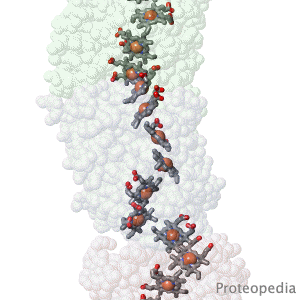Proteopedia:Featured JRN/4: Difference between revisions
Eric Martz (talk | contribs) New page: <table> <tr><td> <imagemap> Image:Featured-omcs-6ef8.gif|center default User:Nikhil Malvankar/Cytochrome nanowires </imagemap> </td></tr> <tr><td><div class="scrolling">'''Geobacter na... |
Eric Martz (talk | contribs) No edit summary |
||
| Line 6: | Line 6: | ||
</imagemap> | </imagemap> | ||
</td></tr> | </td></tr> | ||
<tr><td><div class="scrolling">'''Geobacter | <tr><td><div class="scrolling">'''Geobacter pili: surprising function.'''<br> | ||
''Y Gu, V Srikanth, AI Salazar-Morales, R Jain, JP O'Brien, SM Yi, RK Soni, FA Samatey, SE Yalcin, NS Malvankar''. Nature 2021 doi: [https://doi.org/10.1038/s41586-021-03857-w 10.1038/s41586-021-03857-w]<br> | ''Y Gu, V Srikanth, AI Salazar-Morales, R Jain, JP O'Brien, SM Yi, RK Soni, FA Samatey, SE Yalcin, NS Malvankar''. Nature 2021 doi: [https://doi.org/10.1038/s41586-021-03857-w 10.1038/s41586-021-03857-w]<br>Geobacter pili were long thought to be electrically conductive protein nanowires composed of PilA-N. Nanowires are crucial to the energy metabolism of bacteria flourishing in oxygen-deprived environments. To everyone's surprise, in 2019, the long-studied nanowires were found to be linear polymers of multi-heme cytochromes, not pili. The first cryo-EM structure of pili (2021) reveals a filament made of dimers of PilA-N and PilA-C, shown. Electrical conductivity of pili is much lower than that of cytochrome nanowires. Evidence suggests that PilA-NC filaments are periplasmic pseudopili crucial for exporting cytochrome nanowires onto the cell surface, rather than the pili serving as nanowires themselves. | ||
>>> [[Malvankar/3|Visit I3DC Interactive Visualizations]] >>> | >>> [[Malvankar/3|Visit I3DC Interactive Visualizations]] >>> | ||
Revision as of 02:36, 7 November 2022
 |
Geobacter pili: surprising function.
Y Gu, V Srikanth, AI Salazar-Morales, R Jain, JP O'Brien, SM Yi, RK Soni, FA Samatey, SE Yalcin, NS Malvankar. Nature 2021 doi: 10.1038/s41586-021-03857-w |